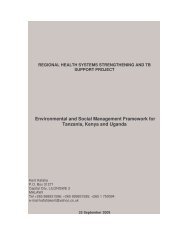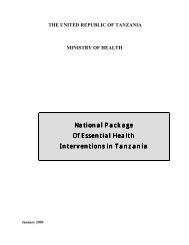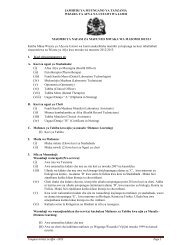Joint External Evaluation of the Health Sector in Tanzania: Draft ...
Joint External Evaluation of the Health Sector in Tanzania: Draft ...
Joint External Evaluation of the Health Sector in Tanzania: Draft ...
Create successful ePaper yourself
Turn your PDF publications into a flip-book with our unique Google optimized e-Paper software.
noted weaknesses <strong>in</strong> supervision. One achievement has been to extend supervision beyond<br />
<strong>the</strong> public system to <strong>in</strong>clude all FBO and private HFs. However, <strong>the</strong> district case studies<br />
note that supervision tends to focus on adm<strong>in</strong>istrative and data management matters<br />
(HMIS) ra<strong>the</strong>r than improv<strong>in</strong>g cl<strong>in</strong>ical practice.<br />
4.4 Community Participation<br />
The most important way <strong>in</strong> which community members are <strong>in</strong>volved <strong>in</strong> <strong>the</strong> plann<strong>in</strong>g and<br />
management <strong>of</strong> council health services is through <strong>the</strong>ir participation <strong>in</strong> PHF committees.<br />
This seems to work relatively well because <strong>the</strong> HF is close to <strong>the</strong> members, committee<br />
members are regular users, and <strong>the</strong>ir contributions have reportedly resulted <strong>in</strong> visible<br />
changes/improvements.<br />
In contrast, participation by community members <strong>in</strong> plann<strong>in</strong>g and monitor<strong>in</strong>g at <strong>the</strong> wider<br />
council level is m<strong>in</strong>imal. In particular, <strong>the</strong> CCHP process <strong>in</strong> <strong>the</strong> six case study districts saw<br />
little <strong>in</strong>volvement from community members. Nyaywa and Petersen’s assessment <strong>of</strong><br />
CCHPs for 2006/07 from 60 districts found that only twelve % had participation from<br />
FBO/VA/CSO/private sector agencies and only three % had representation from <strong>the</strong><br />
wider community. Representatives <strong>of</strong> <strong>the</strong>se organisations <strong>in</strong>terviewed dur<strong>in</strong>g <strong>the</strong> district<br />
case studies <strong>of</strong>ten, but certa<strong>in</strong>ly not always, rated <strong>the</strong>ir participation as m<strong>in</strong>imal.<br />
There are a number <strong>of</strong> possible causes for this lack <strong>of</strong> community participation <strong>in</strong> health<br />
plann<strong>in</strong>g. One may be <strong>the</strong> time constra<strong>in</strong>ts faced by CHMTs and <strong>the</strong> tendency to focus on<br />
<strong>the</strong> CCHP as purely a budget<strong>in</strong>g ra<strong>the</strong>r than a plann<strong>in</strong>g exercise. Ano<strong>the</strong>r possible<br />
explanation could be <strong>the</strong> scarcity <strong>of</strong> competent community members to serve on <strong>the</strong> CHSB<br />
or take part <strong>in</strong> <strong>the</strong> CCHP exercise.<br />
Ultimately, <strong>of</strong> course, <strong>the</strong> lack <strong>of</strong> community participation <strong>in</strong> prepar<strong>in</strong>g CCHPs may reflect<br />
an ongo<strong>in</strong>g and <strong>in</strong>-built tendency for <strong>the</strong> managers <strong>in</strong>volved to see health sector plann<strong>in</strong>g<br />
as <strong>the</strong>ir doma<strong>in</strong> <strong>of</strong> expertise, at least at <strong>the</strong> overall council or district level. It may also be<br />
due to a genu<strong>in</strong>e lack <strong>of</strong> <strong>in</strong>terest on <strong>the</strong> part <strong>of</strong> community members at any level above<br />
<strong>the</strong>ir own health facility, <strong>in</strong> which case it may not be possible make CCHP development<br />
truly participatory.<br />
It was clear <strong>in</strong> <strong>the</strong> case study councils that, once <strong>the</strong> CCHPs are produced, <strong>the</strong>y are not<br />
distributed beyond <strong>the</strong> members <strong>of</strong> <strong>the</strong> Plann<strong>in</strong>g Team, PMO-RALG and MOHSW. The<br />
evaluation did not meet anyone who had a copy <strong>of</strong> <strong>the</strong> CCHP or even extracts <strong>of</strong> <strong>the</strong><br />
relevant pages <strong>of</strong> this. In fact, most had never seen a CCHP for <strong>the</strong>ir council.<br />
4.5 Intersectoral Collaboration<br />
The importance for health <strong>of</strong> close collaboration with o<strong>the</strong>r sectors is emphasised <strong>in</strong> <strong>the</strong><br />
POW (but not <strong>in</strong> <strong>the</strong> HSSP2). Nyaywa and Petersen (2007) found <strong>in</strong> <strong>the</strong>ir assessment that<br />
water and sanitation was <strong>the</strong> number ten priority listed <strong>in</strong> CCHPs, so <strong>the</strong>re is some<br />
evidence that concerns outside <strong>the</strong> traditional health sector are reflected <strong>the</strong>re. On <strong>the</strong><br />
o<strong>the</strong>r hand, <strong>the</strong> district case studies did not f<strong>in</strong>d significant evidence <strong>of</strong> multisectoral<br />
activities at council level. TACAIDS, however, is one example <strong>of</strong> a multisectoral<br />
programme work<strong>in</strong>g at regional and council level.<br />
Devolution should <strong>in</strong> <strong>the</strong>ory facilitate cross-sectoral cooperation at council level. Given <strong>the</strong><br />
fact that clean water and sanitation, hygiene measures, nutritious food and basic education<br />
all substantially contribute to health, active cooperation across sectors could be expected to<br />
34







